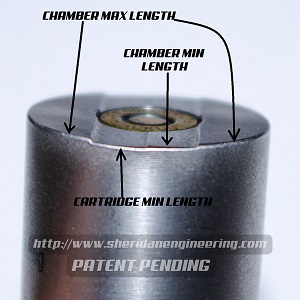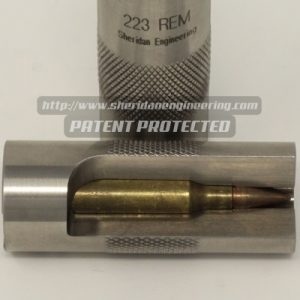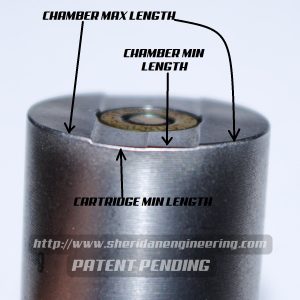Frequently Asked Questions
How does the Ammunition Gauge work?
The basic function of the gauge is just as simple as it seems. If you drop a round in, it should drop in freely, and the top of the case should sit somewhere above the bottom step and below the middle step on the face of the gauge. If it is somewhere in that range, it should fit into an in spec firing chamber without any issue.
Because this is designed to check that your brass will fit in ANY chamber, it is not recommended for use when the brass is only neck sized. Neck sizing is commonly done with bolt actions, where the goal is increased brass life by minimizing the amount of reworking done to the brass. While neck-sized ammunition should fit the chamber of the rifle it was fired in, it may not fit other rifles, and likely will not fit in the gauge.
Ammunition used in semi automatic rifles is typically full length sized for reliable feeding/chambering. This ammunition gauge is designed to work with full length sizing.
What does it tell me if my ammo doesn’t fit the Ammunition Gauge?
The gauge is made to official released cartridge/chamber specs (SAAMI/CIP where applicable). This includes both length measurements like the OAL and headspace, as well as the case diameters. If the brass does not fit all the way in, it could be because one of the length measurements is off, or it could also be because of a diameter is too large. The gauge tells you that you need to inspect these rounds more closely.
Looking at the steps on the face of the gauge, they indicate the chamber min and max length (as shown on SAAMI drawings), and the spec min cartridge headspace length. By sizing the cartridge to be at/below the chamber min(middle step), that ensures that the ammo should fit any chamber in that caliber. And by sizing it to be longer than the cartridge min length(shortest step) that means that it will be be a good fit, and it shouldn't have any issues related to sizing.
Note that the trim length for shouldered cases is not displayed.

How does the Slotted Ammunition Gauge work?
The basic function of the gauge is the same as the standard gauge. If you drop a round in, it should drop in freely, and the top of the case should sit somewhere above the bottom step and below the top step on the face of the gauge. If it is somewhere in that range, it should fit into your firing chamber without any issue. The patented slot down the side of the gauge allows you to check that everything is seating properly into the chamber. So you can visually inspect the cartridge and see that everything fits in the chamber the way it should.
What does it tell me if my ammo doesn’t fit the Slotted Ammunition gauge?
The gauge is made to SAAMI specs (when applicable). This includes both length measurements like the OAL and headspace, as well as the case diameters. If the brass does not fit all the way in, it could be because one of the length measurements is off, or it could also be because of a diameter is too long. Not fitting the gauge tells you that you need to inspect these rounds more closely.
By looking at the cartridge through the slot you can see where the problem is, by seeing what is making contact in the gauge. It could be a problem with headspace, or body diameters, brass trim length, or bullet seating. All of these could cause the ammo to stick up out of a standard gauge and you couldn't tell what was causing it. But the slot allows you to quickly ID which of those problems you have.
Note that the trim length for shouldered cases is not displayed.

What do the different steps on the face of the gauge indicate?
The face of the gauge is equal to the max acceptable headspace length of a SAAMI spec chamber. The middle step is the minimum headspace length of a SAAMI spec chamber. An in spec firing chamber will be somewhere in the range of these 2 slots. To make brass fit any SAAMI spec firing chamber, it should be at the level of, or shorter than the middle step.
The lowest step is the minimum SAAMI spec brass length. If brass is made between the middle step, and and lowest step, it should be in spec, and also fit any in spec firing chamber.

What is the difference between your standard Ammunition Gauge, and other case gauges?
There are several functional differences between our gauge and others. It is a good idea to know these so you can decide which gauge best suits your needs. Our Ammunition Gauge is designed to include the chamber throat, so you can see whether the complete loaded round is within spec. Most other case gauges are designed to just measure the case. As a result most other gauges do not include the throat, but may include a simple check to see if your cases need to be trimmed.
Some case gauges are designed primarily to measure the case headspace and case trim length. In order to do this, they are cut with a larger diameter than normal. This is intentional, and allows cases to drop in, regardless of diameter. The downside of this is that they are not useful as a chamber checker. Problems that could cause a jam such as thick necks, oversized bases, case bulges, and bullet seating issues may not be caught by a case gauge, but can be identified with our gauge. The gauge manufacturer should state whether their case gauge is cut to a larger diameter or not.
Our gauges are designed to check against a tight SAAMI chamber so that what fits in the gauge, should work in any firing chamber. If you are not concerned about making ammunition that is within spec or is capable of working in any gun aside from the one you are loading it for, you may want to use a different tool or no tool at all.
What is the difference between your slotted Ammunition Gauge, and other case gauges?
In addition to all of the differences between the other gauges and our standard gauge, outlined above, our slotted gauge has some very unique advantages. The slot effectively allows you to see how the cartridge fits into a tight chamber. This allows you to visually check that the shoulder is seated properly when you are checking the headspace measurements. If there is any other interference, you can see that as well. It allows you to inspect the entire profile of the cartridge, instead of just seeing if it sits flush in the gauge or not. And it makes it much easier to remove tight rounds.
Our gauges are designed to check against a tight SAAMI chamber so that what fits in the gauge, should work in any firing chamber. If you are not concerned about making ammunition that is within spec, or is capable of working in any gun aside from the one you are loading it for, you may want to use a different tool, or no tool at all.
What is the difference between your Ammunition gauges and headspace comparators or calipers?
Comparators do not measure case diameters, they only take the headspace measurement. They are useful for setting up your dies, but are not useful for doing a complete chamber check. Like some case gauges mentioned above, they will accept an oversized round, so you could check the headspace length to get an accurate measurement of a fired case.
Comparators will provide a measurement, while the gauge itself gives you a simple and quick pass/fail reading. With our gauge, and case gauges as well, calipers could be used to measure the protrusion of the cartridge above the face of the gauge, or above the steps in the face of the gauge. So you can use them to get a measurement with the assistance of calipers.
Just using calipers can get you very accurate measurements to compare against the cartridge specs. There are only two real downsides to this. The first is time. If you are going to check your loaded rounds with calipers, you are going to be spending a lot of time doing it. The second downside is that you are only looking at the single measurement, not how it is tied in with all of the other measurements. All of the measurements on the gauge are tied to the same centerline. A bullet seated at an angle could measure just fine with the calipers, but fail our gauge and not chamber. A concentricity or runout measuring device would give you a good indication and measurement of problems like that. Our Ammunition Gauge will indicate this issue, and much quicker too.
With that said, if you do not own calipers, I would suggest getting them before any other measuring tools. They are useful for many applications, not just reloading.
Can I just buy a standard gauge, or brand X gauge, and slot it myself?
There is a good bit more work that goes into slotting the gauge than just a few minutes cutting the slot. As mentioned previously, the gauge has very tight tolerances. So after the slotting the slots have to be very carefully cleaned and deburred. Any small error in this could mess up headspace measurements or the diameters. So while it is certainly possible to have a machine shop mill a slot in it, you may not get the results you want. And I would not recommend this.
As far as slotting other brand gauges, it is a question of utility. If the gauge is oversized in diameter so that it only is useful for checking headspace or trim length, what will you gain by seeing the slot? You can't check the profile of the cartridge against the gauge because the profile of the gauge is oversized.
Also, please keep in mind that our slotted gauge is patented, with the following utility patents: US9513097B1 and US9863748B2.
What material is the gauge?
All of the standard and slotted gauges are made of 303 stainless steel, and should resist rusting and oxidation. They can be cleaned with normal CLP type cleaners. For best results in gauging, they should be cleaned regularly to reduce the chances of any residue from the brass or ammo building up inside the gauge.
